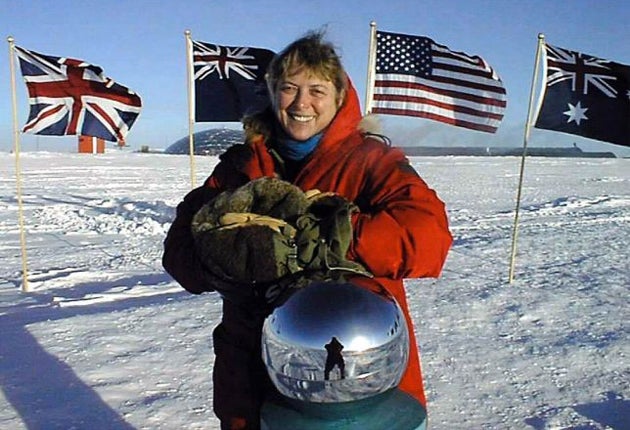Jerri Nielsen Fitzgerald: Doctor who treated herself for cancer while at the South Pole

It was 10 years ago that American doctor Jerri Nielsen FitzGerald discovered at the South Pole, one of the most unforgiving and inhospitable environments on earth, that she had breast cancer. She was the only doctor at the National Science Foundation's Amundsen-Scott South Pole station, a facility cut off for months from the rest of the world by the Antarctic winter.
At first Dr Nielsen, as she then was, kept secret the lump in her breast and swelling lymph nodes under her arm. But then the pain increased.
"I got really sick," she said later. "I had great big lymph nodes under my arm. I thought I was dead. I just thought, 'I'm cooked.'"
But the outside world, and her colleagues at the station, though cut off by snow and ice, rallied round in a remarkable show of determination and solidarity. As a result she died not in 1999 but in 2009. The US military mounted a dramatic rescue mission, and Dr Nielsen played a major part in saving her own life.
Born in Ohio in 1952, she qualified as a doctor and specialised in accident and emergency medicine. She married a classmate but they divorced after 24 years of marriage. Following a particularly messy divorce she saw an advertisement and signed up, on something of a whim, to spend a year at the remote station.
"I wasn't running away, I was changing my life, I was looking for adventure," she would later explain. "I was 46 years old, at the top of my career, and I was asking myself – do I want to do the same thing for the next 20 years?"
She was the only doctor among the station's 41 staff, and like all of the others she had passed rigorous medical tests. But she found her lump just after the Antarctic winter had closed in and cut off physical contact with the rest of the world. This desperate situation called for desperate measures. Dr Nielson established email contact with Indiana University medical school, going over her predicament with specialists.
With their guidance she set to work with the aid of station colleagues, realising there was no option but to treat herself. She carried out a biopsy on herself, having practised the procedure by pushing needles into raw chicken. She recalled: "I froze the area with handfuls of snow, then just went for it. I just jabbed and jabbed until I felt that I had it."
When tests on the tissue sample revealed she had an aggressive form of cancer, doctors and the US military combined in a complex operation which aroused worldwide interest in her plight. For months the Antarctic weather, at almost 100 degrees Fahrenheit below zero, ruled out any aeroplane landing with anti-cancer supplies. But drugs and other equipment were delivered by airdrop, the pilot guided only by firelight.
Dr Nielsen administered these to herself, guided by doctors who were in touch with her by email and video-conferencing, and aided by the polar staff. "We all have that in us to survive, and you will do whatever you need to," she said later. "So I just trained those people, and they did great."
Far from coming to hate the Antarctic during her ordeal, she wrote in one email of a peaceful landscape "with its waves of ice in a hundred shades of blue and white, its black winter sky, its ecstatic wheel of stars."
Her treatment had some effect but by September 1999 the doctors said she should be evacuated to receive proper attention. This was eventually achieved in October when a US National Guard plane made a highly risky landing at temperatures of 58 degrees below zero, collecting Dr Nielsen and leaving a doctor to replace her. She said later: "They said that I had three minutes to get on the plane and get the other doctor off."
Back in the US she underwent multiple operations, including a mastectomy, and her cancer went into remission. She returned to medicine but also became a motivational speaker, giving talks in many countries and lecturing on cruise ships visiting the Antarctic. Her best-selling book on her experience was entitled Ice Bound: a doctor's incredible battle for survival at the South Pole. In it she wrote: "The route to the Pole was, after all, an inner journey. Antarctica was a blank slate on which you could write your soul." It was made into a movie starring Susan Sarandon.
Her cancer returned in 2005, spreading to other parts of her body, but she continued to travel and give talks. Three years ago she remarried: she had met her second husband, Thomas FitzGerald, more than two decades ago on a trip to the Amazon.
"She had incredible zest and enthusiasm for life," he said of her. "She was the kindest soul I ever met, she was intelligent with a great sense of humour, and she lived each day to the fullest."
A further tribute was paid to her by Dr Kathy Miller, the Indiana University cancer specialist who, via e-mail, had supervised her treatment at the South Pole. According to Dr Miller, "She was very passionate about continuing to live her life. She continued to work for many years, she married again, she travelled extensively. I think that gave a lot of our patients hope that, even when disease recurs, life can still go on and we can still find a lot of good things in that life."
David McKittrick
Dr Jerri Nielsen FitzGerald, doctor and motivational speaker on cancer: born 1 March 1952; married firstly (three children), 2006 Thomas FitzGerald; died 23 June 2009.
Subscribe to Independent Premium to bookmark this article
Want to bookmark your favourite articles and stories to read or reference later? Start your Independent Premium subscription today.

Join our commenting forum
Join thought-provoking conversations, follow other Independent readers and see their replies